GNSS (Global Navigation Satellite System) receivers have become an integral part of daily life, often as the source of navigation in cars or smartphones. Although most are familiar with using these receivers to guide them from point A to B, their capabilities extend far beyond this simple use; modern GNSS receivers are highly sophisticated pieces of technology with multiple services; this article will examine some lesser-known ways that they are helping shape our world.
Precise Timing Applications
One of the critical advantages of Global Navigation Satellite System technology (GNSS) is its precise timing information. Thanks to atomic clocks aboard satellites, receivers on the ground can track time down to nanosecond precision for particular timing applications such as:
Financial Transactions
Banks, brokerages, and other financial institutions rely on the precise timing capabilities of GNSS to timestamp transactions and ensure synchronisation across global markets. Based on this timing accuracy, billions of dollars flow through the system daily.
Digital Networks
Communication networks like mobile phones, radio, television, and the internet use GNSS clocks to synchronise data transmission. Without this precise timing, our calls and data would experience significant delays and disruptions.
Power Grid Management
Electric utilities use GNSS timing receivers to monitor phase characteristics and maintain optimal load balancing across the grid. This helps prevent cascading blackouts and other major power disruptions.
Location-Based Services
In addition to timing, the position data from GNSS receivers also fuels a range of groundbreaking location-based technologies and services:
Autonomous Vehicles
Self-driving cars rely on centimetre-level accuracy GNSS positioning integrated with other sensors to navigate safely through traffic. As autonomous vehicles become more prevalent, they will leverage localisation data from GNSS receivers.
Precision Agriculture
Farmers are increasingly adopting GNSS-guided precision agriculture to optimise crop yields. Tractors, sprayers, and other equipment leverage GNSS positioning to automate and pinpoint planting, fertilising, and harvesting operations.
Augmented Reality
The latest augmented reality games and smartphone apps fuse visuals with precise location data from GNSS to overlay contextual digital information onto the physical landscape. For example, historical sites can come to life with AR experiences powered by GNSS receivers.
Atmospheric Monitoring
GNSS satellite signals can also be used to probe the atmosphere and extract valuable data about weather patterns and climate:
Weather Forecasting
As signals from GNSS satellites pass through the atmosphere, subtle changes caused by temperature, pressure, and water vapour can be detected by receivers on the ground. This data improves the accuracy of meteorological models.
Climate Research
Long-term changes in GNSS signal propagation can map variations in atmospheric temperature and composition. This provides insights into climate trends over decades that are useful for climate change research.
Space Weather Tracking
Plasma ejections from the sun and space weather phenomena also influence GNSS signals. Monitoring these fluctuations allows early detection of space weather events that could impact satellites, power grids, and other critical infrastructure.
While most casual users only interact with GNSS through essential navigation apps, the technology offers more excellent utility when leveraged to its full potential. From synchronising wireless networks to guiding autonomous vehicles and monitoring the ionosphere, GNSS receivers provide positioning, timing, and atmospheric data that now permeate numerous aspects of our interconnected world. As researchers uncover fresh applications for GNSS, these versatile devices will continue to be an indispensable technology for modern life.
The Future of GNSS
New satellites, signals, and receiver technologies promise to unlock even greater capabilities from GNSS infrastructure in the years ahead. Some exciting frontiers include:
Internet of Things
Connecting everyday objects and sensors through the internet will be augmented by integrating location and timing data from GNSS receivers. This will help enable smart cities, homes, and wearable tech.
High-Precision Applications
Next-generation GNSS networks with additional satellite constellations broadcasting new signals will drive centimetre and even millimetre-level positioning accuracy. This will benefit autonomous vehicles, robots, and other applications.
Resilient Positioning
With receivers that can access multiple GNSS constellations across different frequencies, the positioning will become more robust and immune to interference. Critical infrastructure will benefit from virtually uninterrupted location data.
Deep Indoor Positioning
New pseudolite transmitters and GNSS repeater networks will expand positioning coverage to deep indoor areas currently difficult for satellite signals to penetrate. This will enable new location-aware applications.
Conclusion
GNSS receivers have evolved lightyears beyond their origins as simple navigational aids. Today, these devices enable precise location awareness and split-second timing that underpins countless innovations improving productivity, efficiency, safety, and convenience across modern economic and social activities. Unlocking the full potential of GNSS requires looking beyond personal navigation to the versatile utility and hidden capabilities of these sophisticated receivers that promise to shape and connect our world in new ways.











